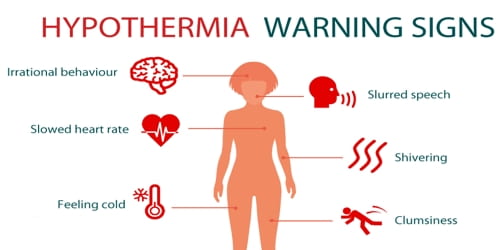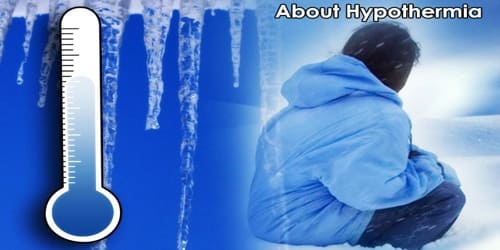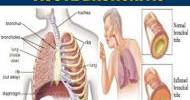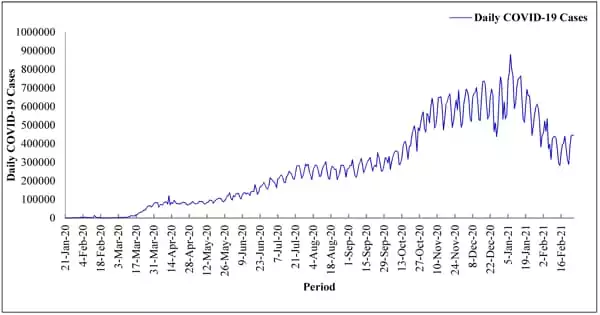About Hypothermia
Definition: Hypothermia is a severe condition in which the body temperature drops to an abnormally low level. It occurs when the body is unable to produce enough heat to counter the heat that it is losing. In humans, it is defined as a body core temperature below 35.0 °C (95.0 °F).
Normal body core temperature ranges from about 98 F to 100 F (36.6 C to 37.7 C); core temperature is best measured by a rectal thermometer; do not rely on an oral, ear, axillary (under the armpit), or skin temperature if hypothermia is suspected.
Symptoms depend on the temperature. In mild hypothermia, there is shivering and mental confusion. In moderate hypothermia shivering stops and confusion increases. In severe hypothermia, there may be paradoxical undressing, in which a person removes his or her clothing, as well as an increased risk of the heart stopping.
Hypothermia may be diagnosed based on either a person’s symptoms in the presence of risk factors or by measuring a person’s core temperature.
The treatment of mild hypothermia involves warm drinks, warm clothing, and physical activity. In those with moderate hypothermia, heating blankets and warmed intravenous fluids are recommended.
Hypothermia is the opposite of hyperthermia, which involves an elevated body temperature and can present as heat exhaustion or heat stroke.

Causes, Sign, and Symptom of Hypothermia: Hypothermia is often defined as any body temperature below 35.0 °C (95.0 °F). The normal human body temperature is often stated as 36.5–37.5 °C (97.7–99.5 °F). Hyperthermia and fever, are defined as a temperature of greater than 37.5–38.3 °C (99.5–100.9 °F).
The body regulates the core temperature by either:
- generating heat
- cooling, or
- heat conservation. Heat conservation can be accomplished by peripheral vasoconstriction and by behavior; heat production is done by shivering and by increasing levels of thyroxine and epinephrine.
Hypothermia usually occurs from exposure to low temperatures and is frequently complicated by alcohol consumption. It also occurs frequently in major trauma and is also observed in severe cases of anorexia nervosa.
Possible causes of hypothermia include:
- Water immersion. Hypothermia continues to be a major limitation to swimming or diving in cold water. The reduction in finger dexterity due to pain or numbness decreases general safety and work capacity, which consequently increases the risk of other injuries. The actual cause of death in cold water is usually the bodily reactions to heat loss and to freezing water, rather than hypothermia (loss of core temperature) itself.
- Other causes. Certain medical conditions such as diabetes and thyroid conditions, some medications, severe trauma, or using drugs or alcohol all increase the risk of hypothermia.
However, the following is a list of symptoms that may occur as hypothermia progresses from mild to severe (temperatures are approximate and some symptoms may overlap).
Mild hypothermia symptoms (core temperature 32 C to 35 C (90 F to 95 F) are:
- Shivering
- Fatigue
- Increased respiratory rate
- Hunger
- Nausea
- Mild confusion
- Some difficulty with speech and coordination
Moderate hypothermia (core temperature 28 C to 32 C (82 F to 90 F) are:
- Increasing difficulty with all the moderate symptoms (for example, inability to do simple tasks, slurred speech)
Severe hypothermia (core temperature below 28 C (82 F) are:
- Shivering stops
- Extreme confusion (for example, removing clothing or extreme risk-taking behavior)
- A decline in consciousness
- A weak and/or irregular pulse
- Slow and shallow breathing
- Coma that can result in death

Diagnosis and Treatment of Hypothermia: Accurate determination of core temperature often requires a special low-temperature thermometer, as most clinical thermometers do not measure accurately below 34.4 °C (93.9 °F).
Temperatures for mild, moderate, and severe hypothermia generally range from:
- Mild hypothermia: 89-95 degrees Farenheit
- Moderate hypothermia: 82-89 degrees Farenheit
- Severe hypothermia: Lower than 82 degrees Farenheit
Because the response to hypothermia varies among individuals, temperatures may differ.
A number of blood tests will be performed as hypothermia can affect almost every organ system in the body. X-rays may be ordered, and an ECG (electrocardiogram) will be done to look at the electrical activity of the heart. The patient might be placed on a monitor to continuously observe their heart rate and watch for arrhythmias.
Treatment depends on the degree of hypothermia, but the aim will be to make the person warm.
Treatments include the following:
- moving the person to a warm, dry place, if possible, or sheltering them from the elements
- removing wet clothing, cutting items away if necessary
- covering their whole body and head with blankets, leaving only the face clear
- putting the individual on a blanket to insulate them from the ground
- monitoring breathing and carrying out CPR if breathing stops
- providing skin-to-skin contact, if possible, by removing clothing and wrapping yourself and the individual in the blanket together to transfer heat
- providing warm drinks, if the individual is conscious, but no alcohol or caffeine
Ideally, treatment will allow the body to return to its normal temperature. At normal temperature, the symptoms of hypothermia should gradually disappear. Consequently, the saying in most emergency departments that treat hypothermic patients is that “the hypothermic patient is not dead until they are warm and dead.”
Information Source:
















